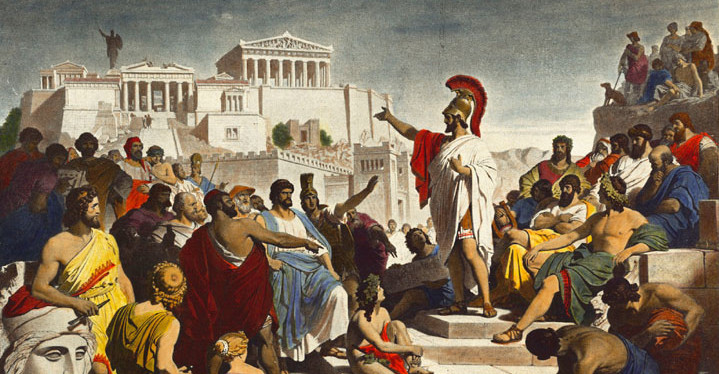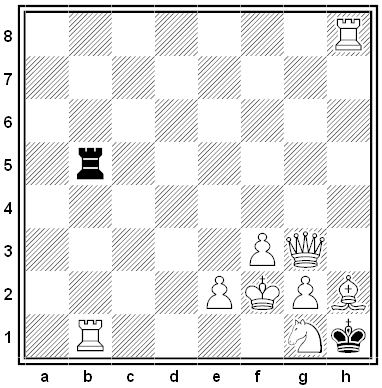“The liar’s punishment is not in the least that he is not believed, but that he cannot believe anyone else.” — George Bernard Shaw
What Am I?
Victorian riddler (and Bishop of Winchester) Samuel Wilberforce offered this conundrum:
I have a large Box, with two lids, two caps, three established Measures, and a great number of articles a Carpenter cannot do without. – Then I have always by me a couple of good Fish, and a number of a smaller tribe, – besides two lofty Trees, fine Flowers, and the fruit of an indigenous Plant; a handsome Stag; two playful animals; and a number of a smaller and less tame Herd: – Also two Halls, or Places of Worship; some Weapons of warfare; and many Weathercocks: – The Steps of an Hotel; The House of Commons on the eve of a Dissolution; Two Students or Scholars, and some Spanish Grandees, to wait upon me.
All pronounce me a wonderful piece of Mechanism, but few have numbered up the strange medley of things which compose my whole.
Lewis Carroll seems to have loved it — he circulated copies to his friends and published this solution in 1866:
The Whole — is Man.
The Parts are as follows.
A large Box — The Chest.
Two lids — The Eye lids.
Two Caps — The Knee Caps.
Three established Measures — The nails, hands and feet.
A great number of articles a Carpenter cannot do without, — Nails.
A couple of good Fish — The Soles of the Feet.
A number of a smaller tribe — The Muscles (Mussels).
Two lofty Trees — The Palms (of the hands).
Fine Flowers — Two lips, (Tulips), and Irises.
The fruit of an indigenous Plant — Hips.
A handsome Stag — The Heart. (Hart).
Two playful Animals — The Calves.
A number of a smaller and less tame Herd — The Hairs. (Hares).
Two Halls, or Places of Worship — The Temples.
Some Weapons of Warfare — The Arms, and Shoulder blades.
Many Weathercocks — The Veins. (Vanes).
The Steps of an Hotel — The Insteps. (Inn-steps).
The House of Commons on the eve of a Dissolution — Eyes and Nose. (Ayes and Noes).
Two Students or Scholars — The Pupils of the Eye.
Some Spanish Grandees — The Tendons. (Ten Dons).
In a Word
verbarian
adj. relating to words
gasconade
n. boastful or bombastic language
philautia
n. self-conceit; undue regard for oneself
procacious
adj. cheeky, provocative
An odd little detail from Boswell’s Life of Johnson:
“His next instructor in English was a master, whom, when he spoke of him to me, he familiarly called Tom Brown, who, said he, ‘published a spelling-book, and dedicated it to the UNIVERSE; but, I fear, no copy of it can now be had.'”
Horology
Terms for times of day in the reckoning of the Malagasy people of Madagascar, from missionary James Sibree’s 1915 book A Naturalist in Madagascar:
midnight: centre of night; halving of night
2:00 a.m.: frog croaking
3:00 a.m.: cock-crowing
4:00 a.m.: morning also night
5:00 a.m.: crow croaking
5:15 a.m.: bright horizon; reddish east; glimmer of day
5:30 a.m.: colors of cattle can be seen; dusk; diligent people awake; early morning
6:00 a.m.: sunrise; daybreak; broad daylight
6:15 a.m.: dew-falls; cattle go out (to pasture)
6:30 a.m.: leaves are dry (from dew)
6:45 a.m.: hoar-frost disappears; the day chills the mouth
8:00 a.m.: advance of the day
9:00 a.m.: over the purlin
noon: over the ridge of the roof
12:30 p.m.: day taking hold of the threshold
1:00 p.m.: peeping-in of the day; day less one step
1:30–2:00 p.m.: slipping of the day
2:00 p.m.: decline of the day; at the rice-pounding place; at the house post
3:00 p.m.: at the place of tying the calf
4:00 p.m.: at the sheep or poultry pen
4:30 p.m.: the cow newly calved comes home
5:00 p.m.: sun touching (i.e. the eastern wall)
5:30 p.m.: cattle come home
5:45 p.m.: sunset flush
6:00 p.m.: sunset (literally, “sun dead”)
6:15 p.m.: fowls come in
6:30 p.m.: dusk; twilight
6:45 p.m.: edge of rice-cooking pan obscure
7:00 p.m.: people begin to cook rice
8:00 p.m.: people eat rice
8:30 p.m.: finished eating
9:00 p.m.: people go to sleep
9:30 p.m.: everyone in bed
10:00 p.m.: gun-fire
Native houses were built with their length running north-south and a single door and window facing west, so they served as rude sundials: By 9 a.m. the sun was nearly square with the eastern purlin of the roof, and at noon it stood over the ridge pole. As the afternoon advanced it peered in at the door and its light crept eastward across the floor, touching successively the rice-mortar, the central posts where the calf was fastened for the night, and finally the eastern wall.
By the People

Think of democracy as a machine. At fixed intervals, the preferences of individual citizens are fed into the machine, and it aggregates them and produces a “choice” of its own. Democratic rule is achieved if, when the machine isn’t working, its most recent choice is acted upon.
“The question now arises: What is the authority of the choice expressed by the machine?” writes philosopher Richard Wollheim. “More specifically, why should someone who has fed his choice into the machine and then is confronted by the machine with a choice non-identical with his own, feel any obligation to accept it?”
(Richard Wollheim, “A Paradox in the Theory of Democracy,” in Peter Laslett and W.G. Runciman, eds., Philosophy, Politics and Society, Second Series: A Collection, 1962.)
“How to Get a Head-Ache”

Naturalists state that snakes, when in danger, have been known to swallow each other; the above three snakes have just commenced to perform this operation. The snakes are from the same ‘hatch,’ and are therefore equal in age, length, weight, &c. They all start at scratch — that is, commence swallowing simultaneously. They are twirling round at the express rate of 300 revolutions per minute, during which time the circumference is decreased by 1 inch.
We would like our readers to tell us what will be the final result? Heads or tails, and how many of each?
— John Scott, The Puzzle King, 1899
Kennedy’s Waffles
For no reason, here’s a recipe for waffles that John Kennedy ate in the White House, “his breakfast treat for special occasions”:
1 tablespoon sugar
1/2 cup butter
2 egg yolks
1 cup and 1 tablespoon sifted cake flour
7/8 cup milk or 1 cup buttermilk
1/4 teaspoon salt
2 egg whites, stiffly beaten
4 teaspoons baking powderCream the sugar and butter. Add the egg yolks and beat. Then add the flour and milk alternately. This mixture may be kept in the refrigerator until you are ready to use it. When you are ready to bake it, fold in the egg whites, and add the baking powder and salt. Bake on a waffle iron. Serves 3.
“President Kennedy liked melted butter and maple syrup on his waffles.”
From White House chef François Rysavy’s 1972 collection A Treasury of White House Cooking.
What’s That?

Suppose now that two philosophers, McX and I, differ over ontology. Suppose McX maintains there is something which I maintain there is not. McX can, quite consistently with his own point of view, describe our difference of opinion by saying that I refuse to recognize certain entities. …
When I try to formulate our difference of opinion, on the other hand, I seem to be in a predicament. I cannot admit that there are some things which McX countenances and I do not, for in admitting that there are such things I should be contradicting my own rejection of them.
It would appear, if this reasoning were sound, that in any ontological dispute the proponent of the negative side suffers the disadvantage of not being able to admit that his opponent disagrees with him.
This is the old Platonic riddle of nonbeing. Nonbeing must in some sense be, otherwise what is it that there is not?
— Willard Van Orman Quine, “On What There Is,” 1948
Black and White
“Moonshine”
A double limerick by Walter de la Mare:
There was a young lady of Rheims,
There was an old poet of Gizeh;
He rhymed on the deepest and sweetest of themes,
She scorned all his efforts to please her:
And he sighed, “Ah, I see,
She and sense won’t agree.”
So he scribbled her moonshine, mere moonshine, and she,
With jubilant screams, packed her trunk up in Rheims,
Cried aloud, “I am coming, O Bard of my dreams!”
And was clasped to his bosom in Gizeh.

